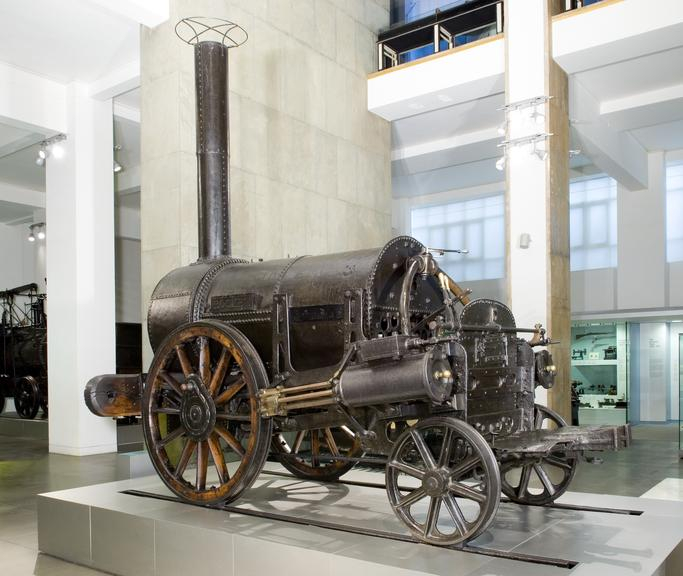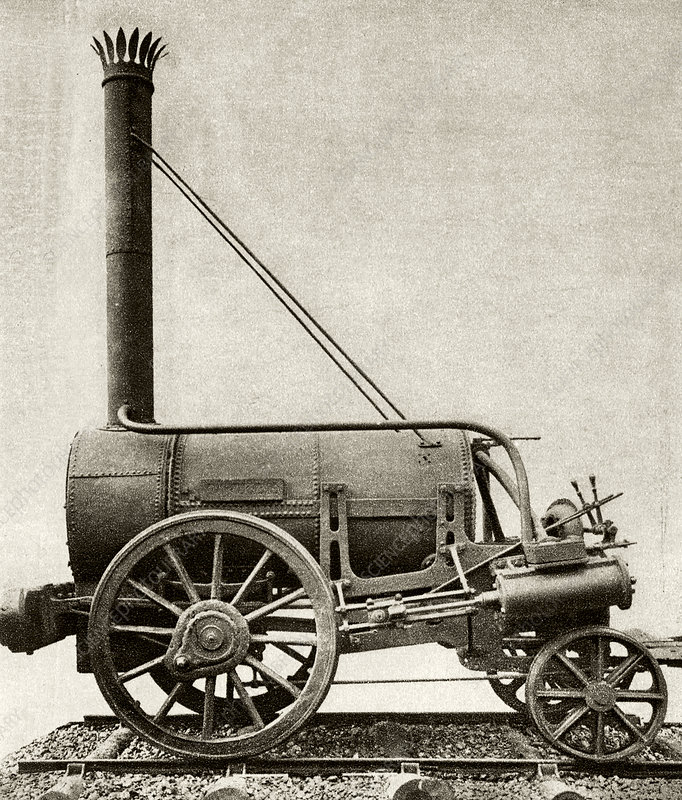Stephenson's Rocket
Stephenson's Rocket is a 0-2-2 wheel layout early steam locomotive. It was built for the Liverpool and Manchester Railway's (L&MR) Rainhill Trials, which were held in October 1829 to demonstrate that improved locomotives would be more efficient than stationary steam engines. Robert Stephenson designed the Rocket in 1829 and built it at his company's Forth Street Works in Newcastle upon Tyne. The Rocket was not the first steam locomotive, but it was the first to combine many advances to create the most sophisticated locomotive of the day. It is the most well-known example of Stephenson's progressive locomotive design, which served as the model for most steam engines for the next 150 years.
The locomotive featured a large smokestack chimney up front, a cylinder boiler in the middle, and a separate firebox at the back. Two external cylinders arranged at an angle drove the huge front pair of wooden wheels. The 0-2-2 wheel configuration was achieved by not coupling the smaller rear wheels to the driving wheels. The locomotive was created by Stephenson specifically for the Rainhill Trials and the competition's requirements. Because the first railway was designed more for passengers than freight, the rules prioritized speed and required reliability, but the locomotive's weight was also strictly limited. The weight restriction for six-wheeled locomotives was six tons, while for four-wheeled locomotives it was four and a half tons. The weight of the train to be hauled, in particular, had to be no more than three times the locomotive's actual weight. Whatever the size of previously successful locomotives, Stephenson knew that this new competition would favor a rapid, light locomotive with relatively limited hauling capability.
Between 1830 and 1840, the history is rather vaguely documented. Rocket worked on the Liverpool and Manchester Railway from 1830 until 1834. Stephenson's Rocket was employed on Lord Carlisle's Railway in Brampton, Cumberland (now Cumbria), England, between 1836 and 1840 after serving on the L&MR. The engine was built as a prototype to win a speed trial, but it was quickly replaced by better designs, such as Stephenson's Northumbrian and Planet designs, both of which were released in 1830. Within a few years, the Rocket had been significantly altered to resemble the Northumbrian class. When compared to the angled configuration when new, the cylinders were moved to a near-horizontal position, the firebox capacity was increased, the design was simplified, and the locomotive was given a drum smokebox.
The locomotive was sold for £300 in 1836 and put into service on the Brampton Railway in Cumberland, which had recently switched to Stephenson gauge. After service, it remained at Tindale until 1862, when it was donated to the London Museum. The Thompsons of Milton Hall, near Brampton, donated Rocket to the Patent Office Museum in London (now the Science Museum) in 1862. The locomotive is still in existence, albeit it hasn't been used since it was turned into a museum exhibit. It was on display at the Science Museum for 150 years, though in a considerably different state than it was during the Rainhill Trials. From September 25, 2018, until September 8, 2019, it was on display at the Science and Industry Museum in Manchester, first in Newcastle and later in Manchester. It has been on display at York's National Railway Museum since 2019.












